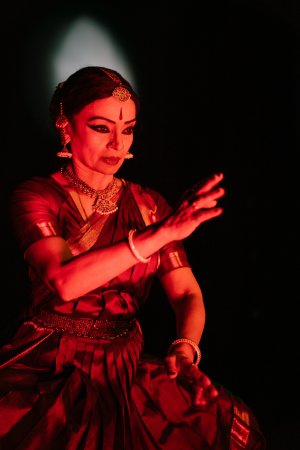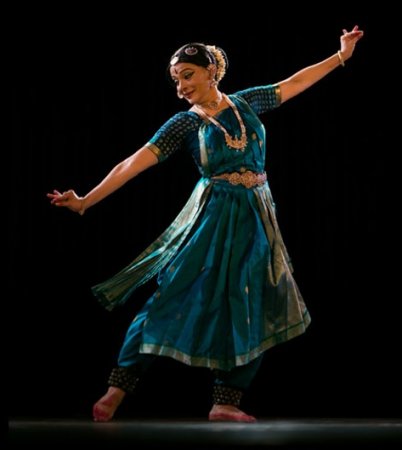
|   |

|   |
 e-mail: leelakaverivenkat@gmail.com When the artiste and the art become one entity in dialogue March 13, 2024 Dance performances are a dime a dozen. But how often, while watching a performance, does one experience a feeling of being transported to another level of consciousness, where one has for a few moments, lost a feeling of oneself? This was the state-of-being I experienced watching Malavika Sarukkai dance in the Angan of her home, before a small gathering of friends. To review such a performance would almost be an affront, for what was an act of worship and thanksgiving at the altar of the Dance muse, for having bestowed on the dancer's person, the benediction of mental and physical vigor to pursue with dedication, the dance for fifty two years - and for still being able to partake of its richness. I am more interested here in the process of what has transpired in the person of the dancer during these long years, with regard to her relationship with the dance.  On this day of registering the date on which she entered the field of dance, Malavika's first thoughts of prayer, very understandably, were for her late mother, without whose dedication, steadfast encouragement and devotion of rocklike support for her dance, this long journey would have been well nigh impossible. She it was, that stood by her through every crisis, and remained her sound board till the end. Malavika also mentioned with deep felt gratitude her great Gurus Rajaratnam Pillai, Kalyanasundaram Pillai, Kalanidhi Narayanan - all stalwarts who put her through her paces, teaching her this great language of Bharatanatyam. The body, we all know, as the dancer's instrument - most wonderful and yet highly vulnerable - has to be trained to become a sharp tool, able to respond to any challenge. Years of steadfast, strenuous training enables, in most cases, the dancer's capacity for technical elaboration. Malavika, right from the time one can recollect, has earned a name for immaculate dance lines while performing. But all this back breaking training finally, in what is essentially a lonely pursuit, somewhat paradoxically, is for the ultimate purpose of achieving a state wherein the dancer can forget and rise above the body, to the realm of the spirit. When the dancer's Self and Art merge as one identity, one has experienced that unity which I feel is the ultimate purpose of one's dance search. It is like finding all the microtones fall into line with the sruti, an inner alignment, which enables the artiste to reach out to that spiritual experience - a magical state of Rasa swadan. Unlike the painter who can work in solitary comfort on his easel, the dancer moves along with the accompaniment of music, and how often does one find musicians and dancer moving on a journey with the same intensity? Here Malavika, who has had her share of problems with musicians, has fortunately during the last few years, had vocalist Dr. Murali Parthasarathy, mridangam vidwan Nellai Balaji and Neela Sukanya's nattuvangam (More recent inclusion is Venkatasubramaniam on violin) - a team of devoted musicians, who have treated daily rehearsals, which are like a ritual for Malavika, with the same intensity. They seem to share the sense of a serious search for that state of wonder and discovery. Without such ardent support from the wings, that sense of magical realization would be difficult. What comprises that experience that goes far beyond prettiness or edification? Malavika began with the prayer to Nataraja - that central motif of the dance of the One who is formless and also endowed with Form - described as clothed in Space. Interestingly Malavika at one point remarked that the feeling she has is not dancing in Space but dancing with Space! It has been said, "The Lord is the Dancer, who like the heat latent in firewood, diffuses his power in mind and matter and makes them dance in their turn" and cosmic activity is set in motion. And how was the dancer given a feel of the power of the Dancer, who had designed the universe itself? The dancer spoke of how her mother would take her to Chidambaram, and talk to her of Shoolapani dancing above all the sculpted panels, of the Lord dancing on the heights. Many of us have been brought up on many descriptions like how the Gods gathering of Gandharas, Yakshas, Apsaras, Uragas, Suddha Sadhus, Vidhyadharas, and all beings of the three worlds assembled to watch this divine dance. When I saw Malavika offer her prayers and take the pose of Nataraja, I felt that she was already seeped in the magic of the dance. When she took a line of the varnam "Sada neevu nanne nu kora" elaborating on it, one could see she was in a realm of her own. Even the pure nritta item had a special punch.  But the lines of Andal seemed to bring out the best in her. The Gopis inviting Krishna entreat that he not destroy their mud castles. It was for me a metaphor - for the intense love cherished by the Gopis is as delicate as sand castles - for one who is worshipped by all but belongs to none, who is there one minute and gone the next. Where is that Krishna? Have you seen him? "Yes," say the Gopis, "I have seen him in Brindavan". Where ultimately is Brindavan? In the hearts and minds of the devotee. The poet describes a vision, the feel of which the dancer needs to capture in the dance. Through the power of being able to communicate with that divine energy called dance, and involvement, she evokes a felt presence with which she has a dialogue. And one could not miss how completely in sync the musicians were. Malavika has arrived at a point in her career, where her art will become more demanding if that is possible - of every bit of her energy, mental and physical coming into play. When the dancer begins to communicate with the dance, not every performance will be able to achieve that delicate balance of total surrender. But that every time she steps on to the stage, it will be to reach out to that spirit she can communicate with. In the process, if she succeeds in creating that magic for the audience, all muscle to her!  Writing on the dance scene for the last forty years, Leela Venkataraman's incisive comments on performances of all dance forms, participation in dance discussions both in India and abroad, and as a regular contributor to Hindu Friday Review, journals like Sruti and Nartanam, makes her voice respected for its balanced critiquing. She is the author of several books like Indian Classical dance: Tradition in Transition, Classical Dance in India and Indian Classical dance: The Renaissance and Beyond. Post your comments Pl provide your name and email id along with your comment. All appropriate comments posted with name and email id in the blog will also be featured in the site. |